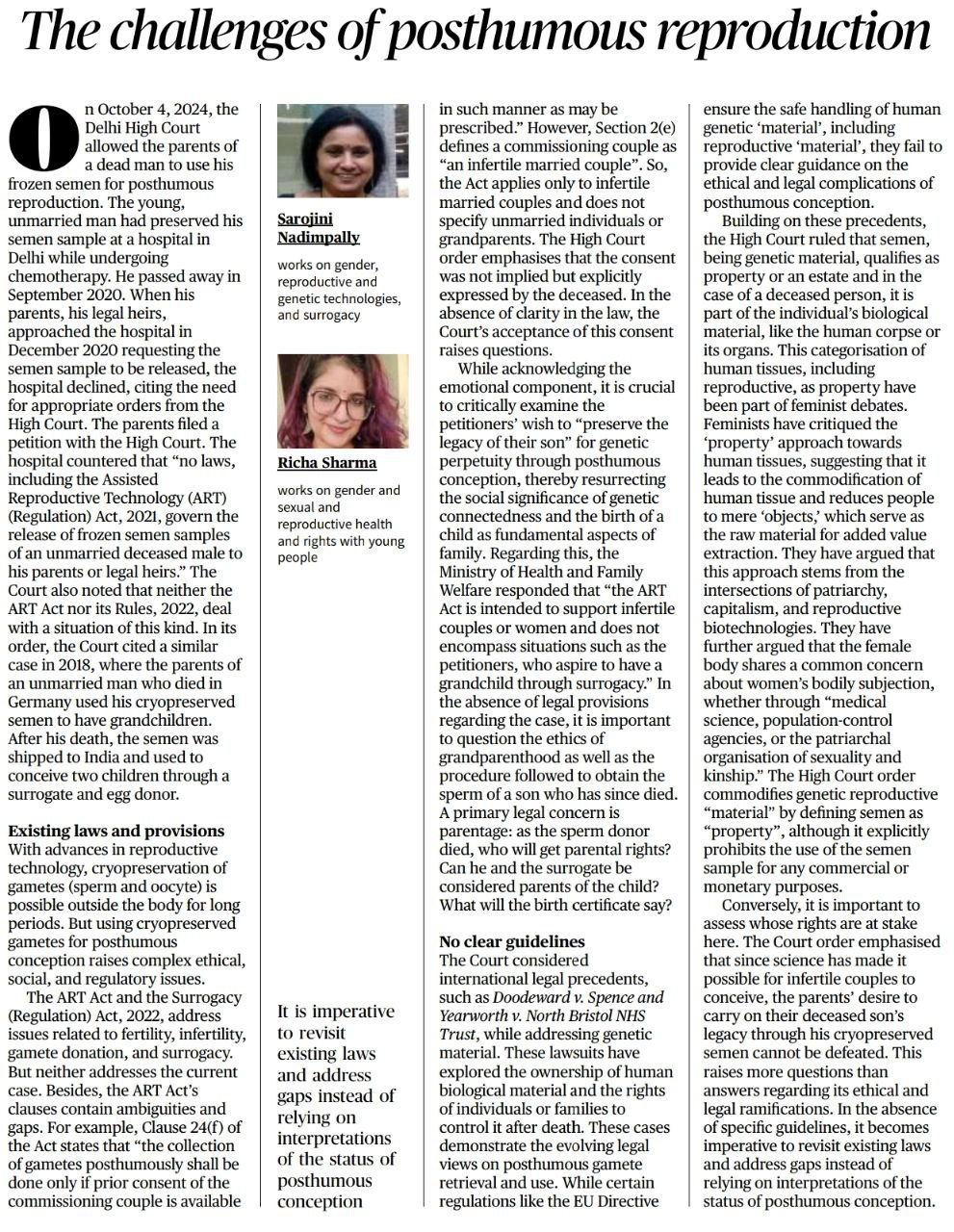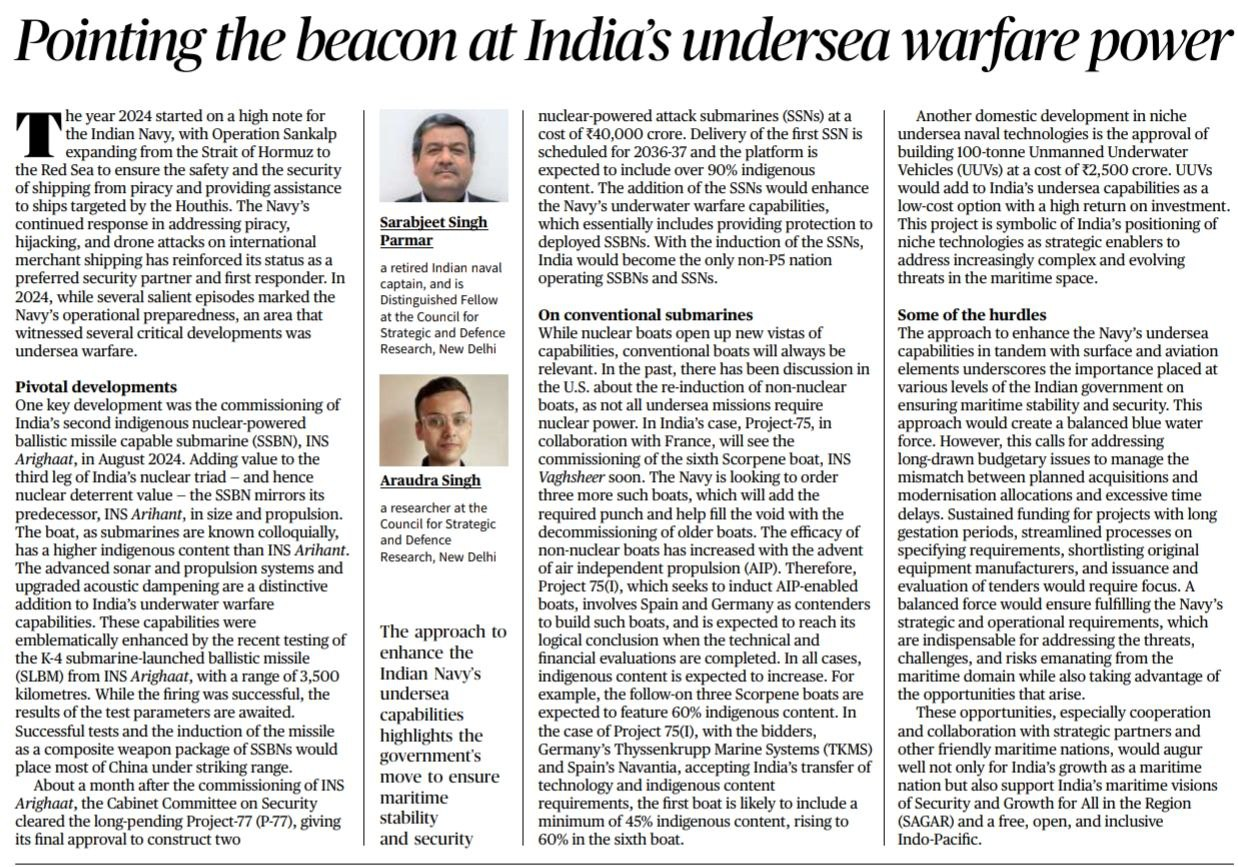1. Legal and Ethical Challenges of Posthumous Reproduction
Introduction
Posthumous reproduction refers to the use of a deceased person’s gametes or embryos for conception. Recent advancements in reproductive technology have brought such practices into the legal and ethical spotlight, especially in cases where parental or familial consent is sought for preserving the genetic legacy of the deceased. The Delhi High Court’s recent ruling permitting the use of a deceased man’s preserved semen for reproduction has reignited debates on the societal, ethical, and legal dimensions of such procedures.
Key Legal Provisions
- Assisted Reproductive Technology (Regulation) Act, 2021:
- Governs the use of reproductive technologies, emphasizing consent and regulation.
- Section 24(f): Prohibits the use of gametes posthumously unless explicit consent is provided by the deceased individual.
- Limitation: Primarily designed for married couples, excluding unmarried individuals or their families.
- Surrogacy (Regulation) Act, 2021:
- Addresses surrogacy-related legalities but lacks clarity on posthumous conception.
Issues and Challenges
- Ethical Concerns:
- Commodification of human genetic material.
- Feminist critiques on treating reproductive material as property.
- Legal Ambiguity:
- Absence of laws addressing situations involving unmarried individuals.
- Uncertainty over parental rights and inheritance in posthumous conception.
- Social Implications:
- Preservation of a deceased individual’s genetic legacy.
- Impact on familial and societal norms regarding parentage and succession.
- International Precedents:
- Reference to cases like Doodeward v. Spence highlights varying global approaches to reproductive rights and the treatment of biological materials.
Arguments in Favor
- Allows families to fulfil the deceased’s unspoken wishes.
- Preserves genetic continuity.
- Expands the scope of reproductive autonomy.
Arguments Against
- Ethical concerns over consent and commodification.
- Risks of exploitation and misuse.
- Lack of robust legal safeguards for all stakeholders.
Conclusion
The issue of posthumous reproduction underscores the urgent need for revisiting and amending existing legal frameworks to accommodate technological advancements and evolving societal values. A balanced approach, addressing ethical, social, and legal dimensions, is essential to ensure the protection of rights and dignity for all parties involved.
Mains Practice Questions |
Discuss the ethical challenges associated with posthumous reproduction and the commodification of reproductive material. |
2. Strengthening India’s Undersea Warfare Capabilities
Introduction
India’s strategic maritime initiatives in 2024 have showcased significant advancements in undersea warfare capabilities. The commissioning of INS Arighat, India’s second indigenous nuclear-powered ballistic missile submarine (SSBN), and the approval of other critical projects underline India’s resolve to bolster its maritime deterrence and safeguard its interests in the Indo-Pacific region.
Key Developments
- Commissioning of INS Arighat:
- Second SSBN of India’s nuclear triad.
- Enhanced indigenous content with advanced sonar, propulsion systems, and acoustic dampening.
- Tested with K-4 submarine-launched ballistic missile (SLBM) with a range of 3,500 km.
- Approval of Project-77 (P-77):
- Construction of two nuclear-powered attack submarines (SSNs) with over 90% indigenous content.
- Delivery expected by 2036-37, enhancing India’s deterrence capabilities.
- Development of Unmanned Underwater Vehicles (UUVs):
- 100-tonne UUV project approved at ₹2,500 crore.
- Strategic addition to maritime surveillance and undersea capabilities.
- Conventional Submarines (Project-75 and Project-75[I]):
- Project-75: Commissioning of INS Vagsheer (sixth Scorpene-class submarine).
- Project-75[I]: Procurement of AIP-enabled submarines with up to 60% indigenous content.
Strategic Significance
- Maritime Deterrence:
- Strengthens India’s nuclear triad, keeping adversaries within strike range.
- Enhances operational readiness and response capabilities.
- Regional Stability:
- Supports India’s SAGAR (Security and Growth for All in the Region) vision.
- Aligns with the Indo-Pacific strategy for a free and inclusive maritime domain.
- Technological Advancements:
- Promotes indigenous development in defense manufacturing.
- Boosts long-term self-reliance in critical defense technologies.
Challenges
- Delays and Bureaucratic Hurdles:
- Long gestation periods for submarine projects.
- Mismatch between planned acquisitions and actual modernization.
- Financial Constraints:
- High costs associated with nuclear and conventional submarine programs.
- Dependence on External Partnerships:
- Reliance on foreign collaborators for technology transfer.
- Operational and Logistic Issues:
- Limited manufacturing and maintenance infrastructure.
- Need for a skilled workforce to operate advanced systems.
Way Forward
- Streamlining Procurement:
- Address delays in decision-making and approvals for defense projects.
- Ensure alignment between modernization goals and resource allocation.
- Strengthening Partnerships:
- Collaborate with strategic allies for technology transfer and joint ventures.
- Enhancing Indigenous Capabilities:
- Invest in research and development for underwater technologies.
- Encourage domestic manufacturers to participate in defense projects.
- Holistic Maritime Policy:
- Integrate naval capabilities with broader maritime strategies.
- Focus on SAGAR and Indo-Pacific initiatives to ensure regional security.
Conclusion
India’s advancements in undersea warfare reflect a strategic commitment to enhancing maritime security and deterrence. With initiatives like Project-77, Project-75[I], and the deployment of UUVs, India is positioning itself as a significant maritime power in the Indo-Pacific. However, addressing challenges in procurement, infrastructure, and funding will be crucial for realizing its long-term maritime ambitions.
Mains Practice Questions |
Analyze the strategic importance of India’s nuclear-powered submarine program in strengthening its maritime security. (250 words)
|
3. India's Challenges in the Fight Against Global Warming
Introduction
Global warming has emerged as one of the most pressing challenges of the 21st century. The COP29 conference highlighted the persistent gap between international climate negotiations and tangible outcomes. While developed countries have pledged to achieve net zero emissions by 2050, India faces unique challenges as it balances development priorities with climate commitments, aiming for net zero by 2070.
Key Developments in Global Climate Policy
- EU Carbon Border Adjustment Mechanism (CBAM):
- Effective from 2026; imposes customs duties on imports unless exporting countries match EU carbon taxation levels.
- Implications for Indian exporters.
- Peak Emissions Agreements:
- G7 Hiroshima Summit (2023) emphasized ‘peaking of emissions.’
- India’s challenge: Aligning peak emission timelines with its development trajectory.
India’s Key Challenges
- Energy Transition:
- India’s energy consumption: 1/3rd of the global average.
- Need for greater diversification and ramping up of clean energy sources (renewables, hydrogen, and nuclear).
- Infrastructure and Investment:
- Existing coal plants sanctioned or under construction.
- Electrification of transport and industry: Increased demand for clean electricity.
- Cost and Land:
- Renewables: High land requirements and investment costs.
- Nuclear: Long gestation period for deployment and public concerns over safety.
- Global Financing Gap:
- COP29 financial commitments: $300 billion per year by 2030.
- Challenges in accessing international climate funds for developing countries.
Opportunities for India
- Renewable Energy Leadership:
- Scaling solar, wind, and green hydrogen industries.
- Leveraging partnerships for technology transfer.
- Innovation in Energy Storage:
- Developing cost-effective solutions for energy storage and grid stability.
- Economic Growth and Sustainability:
- Transitioning to a low-carbon economy while ensuring inclusive growth.
- Strategic Alliances:
- Collaboration with multilateral development banks and private sector investment.
Conclusion
India’s path to achieving net zero emissions by 2070 necessitates bold policy decisions, substantial investments in clean technologies, and international cooperation. Bridging the gap between development needs and environmental sustainability will be critical for India to lead the global fight against climate change.
Mains Practice Questions |
Critically examine the challenges India faces in transitioning to clean energy sources in the context of global climate commitments. (250 words) |




